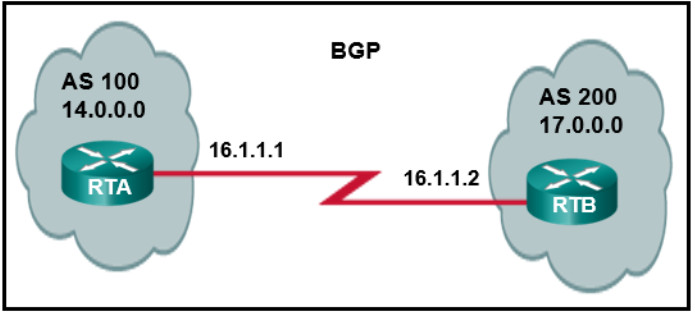1. Which transport layer port is used in BGP peering?
- UDP port 289
- TCP port 289
- UDP port 179
- TCP port 179
2. What is the first BGP message type that is sent after a TCP session is established between BGP peers?
- hello
- keepalive
- notification
- open
- update
3. Refer to the exhibit. Which two configurations will allow RTA to establish a neighbor relationship with RTB? (Choose two.)

- RTA(config)# router bgp 100
RTA(config-router)# network 17.0.0.0 - RTA(config)# router bgp 100
RTA(config-router)# network 14.0.0.0
RTA(config-router)# neighbor 16.1.1.2 remote-as 200 - RTA(config)# router bgp 200
RTA(config-router)# network 17.0.0.0
RTA(config-router)# neighbor 16.1.1.1 remote-as 100 - RTB(config)# router bgp 200
RTB(config-router)# network 14.0.0.0 - RTB(config)# router bgp 200
RTB(config-router)# network 14.0.0.0
RTB(config-router)# neighbor 16.1.1.2 remote-as 200 - RTB(config)# router bgp 200
RTB(config-router)# network 17.0.0.0
RTB(config-router)# neighbor 16.1.1.1 remote-as 100
4. Refer to the exhibit. A network administrator issues the show bgp ipv4 unicast 172.16.0.0 command to check the route information in the BGP table. Which statement describes the characteristic of the advertisement of this route?

- The route is advertised through IGP.
- The route is advertised through a static route.
- The route is advertised without including path attributes before the aggregation.
- The route is advertised with the
aggregateaddress 172.16.0.0 255.255.240.0command.
5. What is used by BGP to determine the best path to a destination?
- cost
- hop count
- attributes
- administrative distance
6. Which routing protocol is used to exchange routing information between autonomous systems on the Internet?
- IS-IS
- EIGRP
- OSPF
- BGP
7. True or False? Multiple BGP processes can run on a router.
- true
- false
8. What is the correct BGP command to summarize the addresses from 172.16.0.0 through 172.16.15.0 into a single address that will be advertised by BGP?
- summary-address 172.16.0.0 0.15.255.255 summary-only
- summary-address 172.16.0.0 255.255.240.0 summary-only
- aggregate-address 172.16.0.0 0.15.255.255 summary-only
- aggregate-address 172.16.0.0 255.255.240.0 summary-only
9. Refer to the exhibit. A network administrator issues the command show bgp ipv6 unicast | begin Network to check the BGP table. Which statement describes the routes with an unspecified address (::) in the Next Hop column?

- They are learned through an IGP.
- They are locally generated network prefixes.
- They indicate routes created by static route configuration.
- They are learned through BGP advertisements from the next neighbor.
10. Refer to the exhibit. A network administrator issues the show bgp ipv4 unicast command to check the routes in the BGP table. What does the symbol > indicate about a route?

- It is a route that is learned through IGP.
- It is the best route for the network prefix.
- It is a route that is learned through a static route.
- It is a route to an interface that is connected to the router.
11. What change was made to BGP to address the expected depletion of autonomous system numbers?
- the ability to incorporate hierarchical network design
- the use of a 2-octet autonomous system number
- the use of a 4-octet autonomous system number
- the ability to use RFC 1918 address space
12. What is a characteristic of an IBGP session type?
- Neighbors may be located anywhere within multiple autonomous systems, even several hops away from each other.
- A session typically occurs between routers in different autonomous systems with multiple ISPs.
- It can be established between routers in the same AS or that participate in the same BGP confederation.
- It occurs between routers in two different autonomous systems.
“Do I Know This Already?” Quiz Answers:
1. Which of the following autonomous systems are private? (Choose two.)
- 64,512–65,535
- 65,000–65,535
- 4,200,000,000–4,294,967,294
- 4,265,000–4,265,535,016
2. Which BGP attribute must be recognized by all BGP implementations and advertised to other autonomous systems?
- Well-known mandatory
- Well-known discretionary
- Optional transitive
- Optional non-transitive
3. True or false: BGP supports dynamic neighbor discovery by both routers.
- True
- False
4. True or false: A BGP session is always one hop away from a neighbor.
- True
- False
5. True or false: The IPv4 address family must be initialized to establish a BGP session with a peer using IPv4 addressing.
- True
- False
6. Which command is used to view the BGP neighbors and their hello intervals?
- show bgp neighbors
- show bgp afi safi neighbors
- show bgp afi safi summary
- show afi bgp interface brief
7. How many tables does BGP use for storing prefixes?
- One
- Two
- Three
- Four
8. True or false: BGP advertises all its paths for every prefix so that every neighbor can build its own topology table.
- True
- False
9. Which BGP command advertises a summary route to prevent link-flap processing by downstream BGP routers?
- aggregate-address network subnet-mask as-set
- aggregate-address network subnet-mask summary-only
- summary-address network subnet-mask
- summary-address network mask subnet-mask
10. True or false: The IPv6 address family must be initialized to establish a BGP session with a peer using IPv6 addressing.
- True
- False
